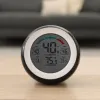If you have pets, you have indoor air quality concerns that non-pet owners don’t have.
Aside from pet dander that can aggravate allergies, you’ve got to deal with unpleasant odors and whatever unfortunate environmental allergens Rover tracks across the living room rug.
To be clear: Fish, lizards, and pet rocks aren’t the culprits here. We’re talking about cats, dogs, and other furry creatures with whom you share your home.
The good news is that there are steps you can take to bring indoor air quality up to a standard that’s comparable – if not higher – than that which non-pet owners already enjoy. Take these five tips to heart if you’re looking to optimize indoor air quality, even as Fido and Cleo continue running amok.
1. Understand what’s in your air
The big issue with pets and indoor air quality is what you don’t see.
We all see pet hair. It gets on the upholstery and sticks to our clothes. But pet hair isn’t your biggest concern when it comes to indoor air quality. The hair, in and of itself, isn’t making your air unclean.
What we are concerned about is the dander.
Dander, of course, is the name for little bits of dried saliva (your pets lick themselves, you know) and the skin that your pets slough off. It adheres to surfaces and blows around in your home. When allergic people inhale air that’s saturated with dander, it can aggravate their allergies.
Cats are the biggest offenders here because they spend a lot of the day licking themselves. But dogs do it, too. Anyway, it’s the dander – not the hair – that you should be concerned about when it comes to filtering out indoor pollutants.
2. Get a media filter
This is the simplest, lowest-fuss way to filter the pet dander in your air.
Compared to standard 1″ filters (pleated and otherwise), media filters do a much better job filtering air. They filter out the smaller, finer pollutants in your air to a much greater extent than standard filters and have MERV values between 11 and 14.
Thanks to their relatively large surface area relative to standard filters, media filters also filter air without inhibiting airflow through your HVAC system. You get better indoor air quality without any negative impact to airflow through your system.
Most media filter manufacturers recommend replacing or cleaning the filter once per year. If you have pets, we may recommend replacing it twice per year.
3. Consider a HEPA filter
Media filters will be sufficient for many people. You’ll filter out more of the aggravating dander and breathe easier than with a standard filter.
However, people with serious allergies or who frequently host allergic people in their homes will almost certainly need something stronger. A HEPA filter is the way to go here because it can capture, well… practically everything.
With a HEPA filter, particles as small as 0.3 microns in diameter (a human hair is about 45 microns wide, for comparison) get snagged inside the extremely dense filter media. A HEPA filter is so dense that it requires a separate fan to move air through the filter. That’s why we often refer to HEPA filters as HEPA systems. It’s not just the filter – you also need a fan to push air through it.
For a filtration system that’s built to last, easy to maintain, and is basically invisible inside your home, we recommend a bypass HEPA system that interfaces with your HVAC system. These systems integrate with your ductwork and move air through the HEPA system before it’s heated or cooled. By the time the air enters your lungs, it’s a comfortable temperature and extremely clean.
Standalone HEPA filters are also an option. Look for portable HEPA models that are well built, don’t take up too much space, and don’t have demanding maintenance requirements. In our experience, Austin Air Cleaners are a good choice.
4. Dilute pet odor with an ERV
We’ve talked about air filtration, which is all about removing particle pollutants from the air. But what if your pets just stink?
Around here, we love dogs and cats as much as you do. We also understand that some of our furry friends just tend to be stinkier than others, whether or not they’re actually rolling around outside and obviously getting dirty.
Also, if your vet told you not to bathe your dog too often (ours did!), you might be wondering how to dilute Spot’s, um… foul-ish smelling odor during the weeks leading up to bathtime. Enter the ERV.
An ERV, or energy recovery ventilator, is a ventilation device that replaces the stale, smelly air inside your home with fresh, outdoor air. Here in Atlanta, that might sound like a questionable strategy given that our air is often hot, humid, and full of pollen. But fear not! And ERV also:
- Filters incoming air for environmental pollutants, such as pollen, before it enters your home
- Transfers humidity and heat from the incoming air to the outgoing air stream, so the air entering your home isn’t as humid or hot as what’s outdoors
With an ERV, you can make the air inside your home smell good! Say so long to the “dog odor tidal wave” that otherwise greets you the moment you open the door.
When properly configured, an ERV also won’t pressurize your home. It’s a 1-to-1 air exchange device, so it removes the same amount of air as it introduces. The result is cleaner, fresher, better smelling air.
5. Get aggressive about fresh air with a dehumidifier
This is kind of an add-on for people who opt for an ERV to dilute pet odors. It applies to our climate zone (the Southeastern United States) but may be relevant elsewhere, too.
In warm, humid climates, ERVs are simply the best way to ventilate your home. The thing is – and this is mainly the case during the three hottest, most humid months of the year – an ERV’s humidity transfer still might not be enough for you. In other words, the air your ERV brings in will be less humid than the outdoor air, but it still might be too humid.
ERVs, after all, aren’t dehumidifiers. They transfer humidity from the incoming air to an outgoing air stream. But they don’t actively remove humidity from the incoming air.
So, what is the odor-aware pet owner to do? You love having an ERV to dilute the air, but you want the air to be drier and more comfortable.
Here’s where dehumidifiers come in. Yes, you can get a standalone unit or two. But those require manual daily water trough changes. They also take up space and make noise.
A better solution is the whole-house dehumidifier. Paired with an ERV and a good air filter, you’ve got the absolute best solution for pet related odors and pollutants. Plus, you’ll be a whole lot more comfortable from June to August!
Whole-house dehumidifiers integrate with your HVAC system and remove humidity from the air before it enters your air handler. They will even run while your air conditioner isn’t on, ensuring that the air inside your home is always dry and comfortable. These units essentially “pick up the slack” when your AC can’t remove enough humidity or when an ERV introduces more humidity than you’d like.
Need help improving air quality in your home?
We can point you toward the best options for you, your pets, and your family!
If you live in the Atlanta area and are concerned about your home’s indoor air quality, get in touch with us. Our team can help you select the filtration and odor control options that make the most sense for your needs and budget!





